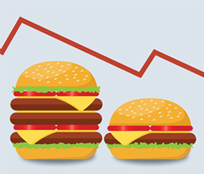Within the April Consumer Price Index (CPI) release today from the Bureau of Labor Statistics, both headline and core CPI inflation proceeded at a seasonally adjusted monthly rate of 0.4%. Core inflation was slightly faster than the headline, annualizing to a 5.0% per year rate, compared to 4.5% for the headline measure.
Used car prices bounced 4.5% on the month—a really big gain if you annualize it—after having declined steadily over the previous 14 months. Meanwhile, food prices continued to moderate, holding flat for the second straight month, and hotel bills and airfares declined—by -3.4% and -2.6% non-annualized, respectively, after both components had bounced in February and March. For the record, we should point out that the importance (weight) of used cars in the CPI is three times as large as that of hotels and air travel combined, hence the higher readings on core inflation in the chart than we had seen in previous months.
Meanwhile, we have been waiting for some lower prints on shelter inflation, expecting them to reflect the on-the-ground realities of falling home prices and falling rents in recent months. We’re still waiting. Shelter inflation as reported in the CPI has fallen from 9.5% +/- readings late last year to 6.5% +/- over the last two months, but that is still too a high rate of reported change.

Even apart from shelter, other “core” items have indeed bounced in recent months, as seen in the chart. We show Personal Consumption Expenditures (PCE) inflation data there as well as CPI data, because it is the PCE index that the Fed targets, and while the two measures tend to move together, you can see enough divergence between them that it is worth reporting both. April PCE inflation will be reported on May 26.
We have been thinking that watching the economy slow has been like watching paint dry—nothing dramatic, but only gradually cumulative changes. Well, watching inflation slow has been like watching a game of whack-a-mole. Progress on one front has been typically countered by backsliding (bounces) on others. Thus, the moves lower in food and various services are swamped in some months by the bounces elsewhere, and when the latter bounces later reverse, something else bounces.
Yes, the overall pattern has been of a gradual deceleration in inflation (paint drying on a whack-a-mole platform?). And yes, the bond markets today seem to be finding solace in the fact that the CPI print was not even worse. However, the prints in recent months have not been at rates that would convince the Fed that its inflation-fighting efforts are nearly complete. For coming months’ data, drier paint please.



